Utilization of a Telemetry Monitoring System for the Dynamics of Water Quantity and Quality in the Dadahup Swamp Irrigation Area †
Abstract
:1. Introduction
2. Material and Methods
2.1. Study Area
2.2. Methods
2.3. Characteristics of the Dadahup Swamp Irrigation Area
2.4. Water Quantity and Quality
3. Results and Discussion
3.1. Water Quantity Dynamics Profile
3.2. Water Quality Dynamics Profile
4. Conclusions
Author Contributions
Funding
Institutional Review Board Statement
Informed Consent Statement
Data Availability Statement
Acknowledgments
Conflicts of Interest
References
- Santosa, E. Percepatan Pengembangan Food Estate Untuk Meningkatkan Ketahanan Dan Kemandirian Pangan Nasional. Risal. Kebijak. Pertan. DAN Lingkung. Rumusan Kaji. Strateg. Bid. Pertan. dan Lingkung. 2015, 1, 80. [Google Scholar] [CrossRef]
- Arif, M.I.; Legono, D.; Luknanto, D. Study on the Performance of the Hydraulics System Planning of Swampy Irrigation Area of Dadahup, Kapuas District, Central Kalimantan Province. IOP Conf. Ser. Earth Environ. Sci. 2021, 930, 1–10. [Google Scholar] [CrossRef]
- Arif, M.I.; Legono, D.; Luknanto, D.; Wignyosukarto, B.; Marpaung, M.F. Behavior of Flow of Channel Network of Dadahup Swampy Irrigation Area. In IOP Conference Series: Earth and Environmental Science; IOP Publishing: Bristol, UK, 2022; Volume 1091, p. 012035. [Google Scholar] [CrossRef]
- PT. Virama Karya Persero (KSO) Cabang Semarang – PT. Wiratman – PT. Archiegama Bangun Cipta Pratama. Laporan Akhir Survey Investigasi Desain (SID) Rehabilitasi dan Peningkatan Jaringan Irigasi Rawa Wilayah Kerja Blok A; Kalimantan II River Basin Center Palangka Raya at the Directorate General of Water Resources: Palangka Raya, Indonesia, 2020. [Google Scholar]
- Setiadi, D.; Muhaemin, M.N.A. Penerapan Internet of Things (IoT) Pada Sistem Monitoring Irigasi (SMART IRIGASI). J. Infotronik 2018, 2, 95–98. [Google Scholar] [CrossRef]
- Zevri, A.; Rahardjo, A.P.; Legono, D. Swamp Water Parameter Dynamics Induced by Rainfall and Tides in Dadahup Irrigation Area, Kalimantan. In IOP Conference Series: Earth and Environmental Science; IOP Publishing: Bristol, UK, 2022; pp. 1–10. [Google Scholar] [CrossRef]
- Istianto, H.; Bernard, R.; Suryadi, F.X. Improving the performance of tidal irrigation through the water management, (study case gandus Palembang, South Sumatra). In Proceedings–International Association for Hydro-Environment Engineering and Research (IAHR)-Asia Pacific Division (APD) Congress: Multi-Perspective Water for Sustainable Development, IAHR-APD 2018; Curran Associates, Inc.: Red Hook, NY, USA, 2018; Volume 1, pp. 677–685. [Google Scholar]
- Wignyosukarto, B.S. Konsep Pengembangan Pola Tata Air Lahan Gambut. Forum Tek. 2000, 24, 342–357. [Google Scholar]
- Purboseno, S.; Suparyanto, T.; Hidayat, A.A.; Pardamean, B. A Hydrodynamic Analysis of Water System in Dadahup Swamp Irrigation Area. In Proceedings of the 2021 1st International Conference on Computer Science and Artificial Intelligence (ICCSAI), Jakarta, Indonesia, 28 October 2021; pp. 400–406. [Google Scholar] [CrossRef]
- Noor, M.; Anwar, K.; Kartiwa, B. Sistem Polder untuk Pengembangan Pertanian Berkelanjutan di Lahan Rawa Lebak; IAARD PRESS: Kota Bogor, Indonesia, 2017; pp. 22–38. [Google Scholar]
- Suriadikarta, D.A. Teknologi Pengelolaan Lahan Rawa Berkelanjutan: Studi Kasus Kawasan Ex PLG Kalimantan Tengah. J. Sumberd. Lahan 2012, 6, 45–54. [Google Scholar]
- Blunden, B.; Indraratna, B. Pyrite Oxidation Model for Assessing Ground-Water Management Strategies in Acid Sulfate Soils. J. Geotech. Geoenviron. Eng. 2001, 127, 146–157. [Google Scholar] [CrossRef]

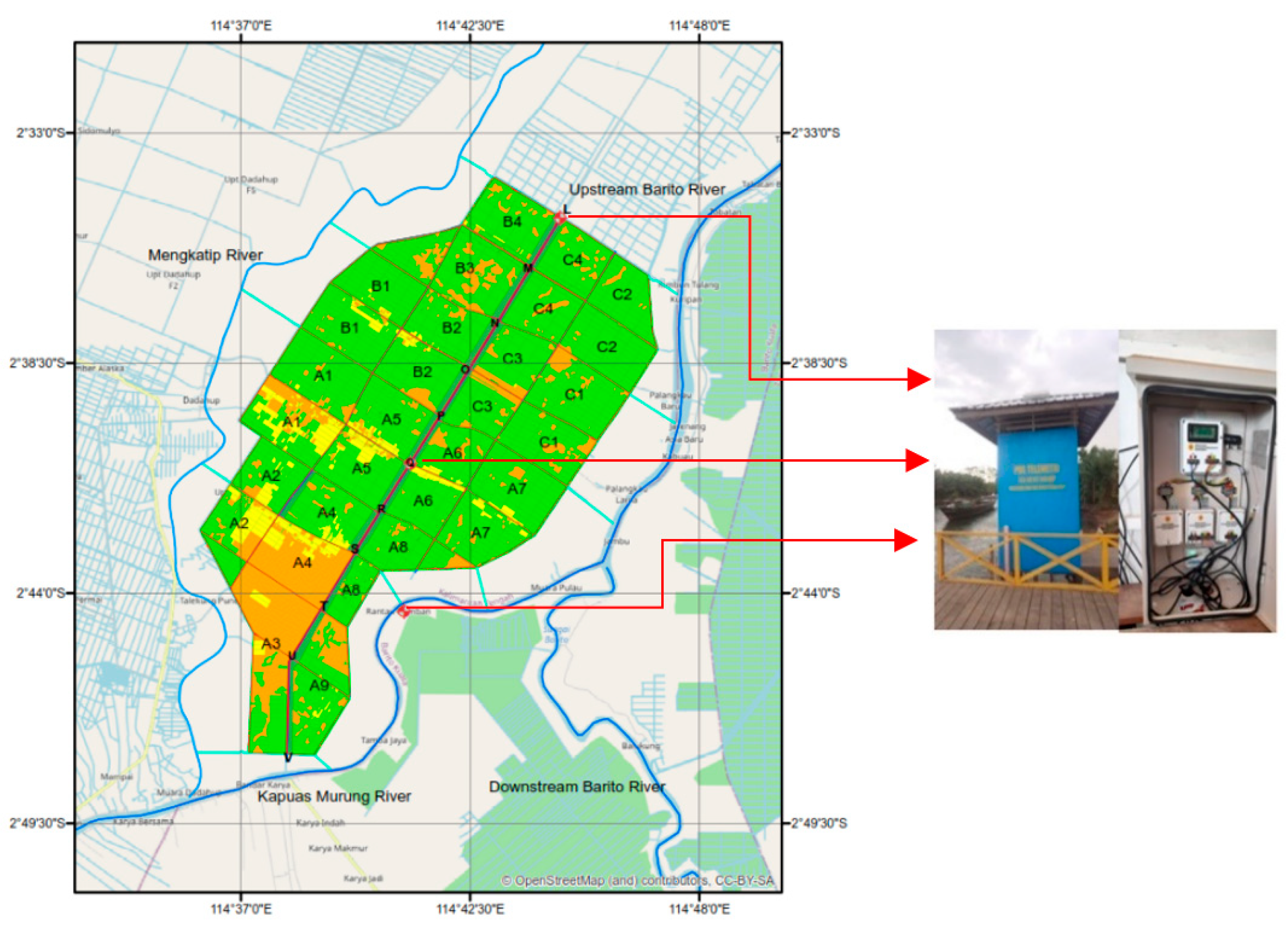
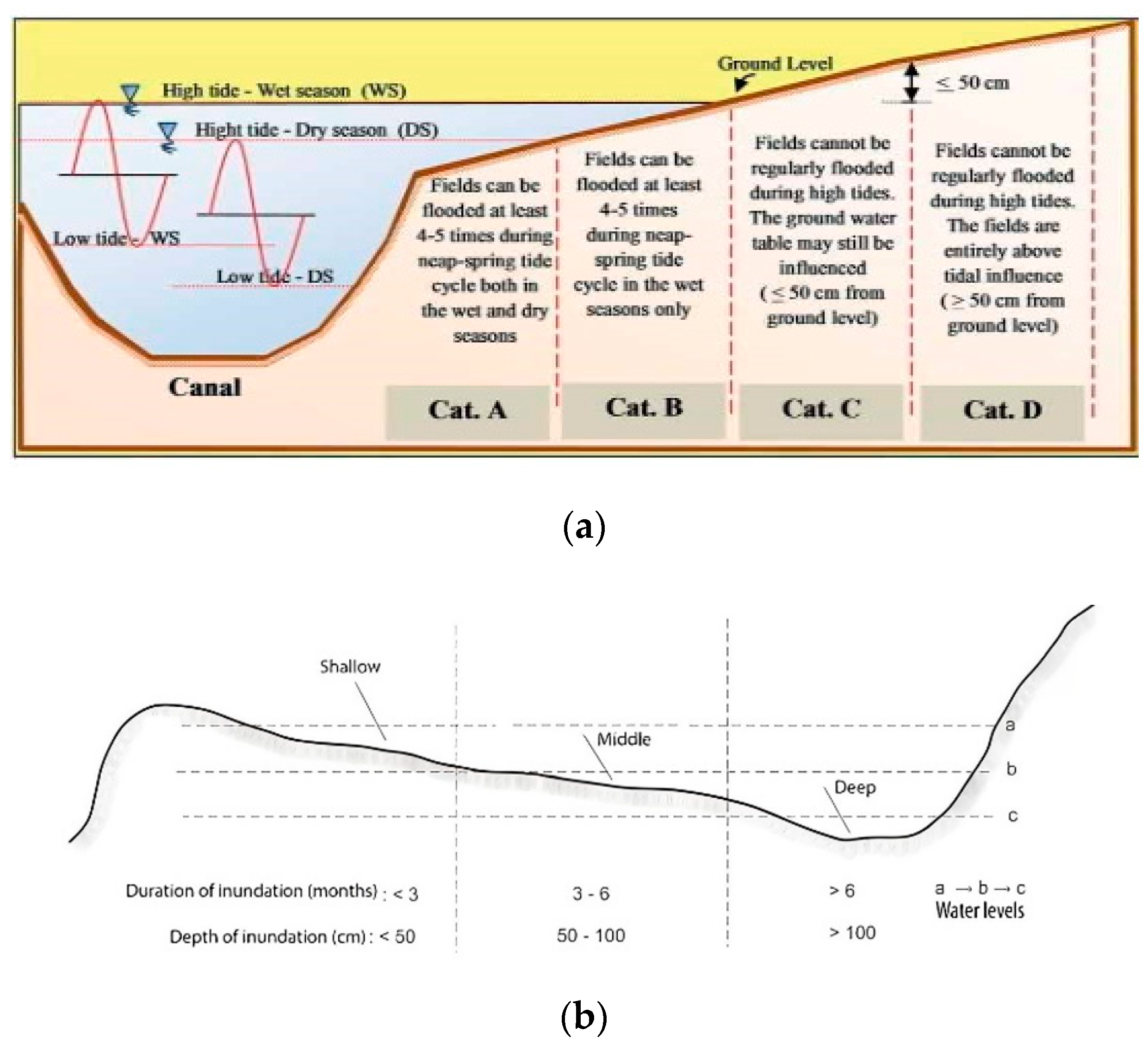
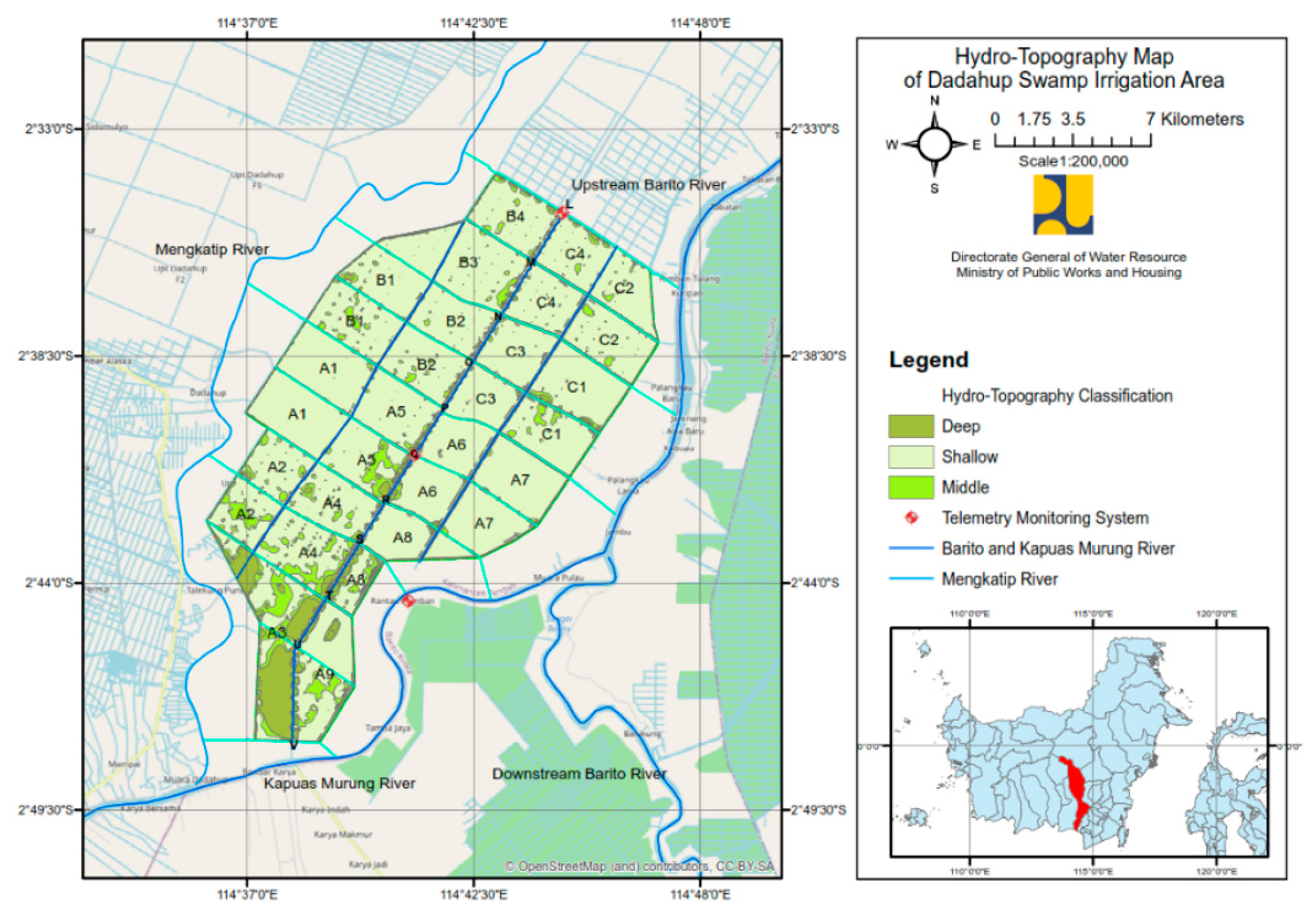
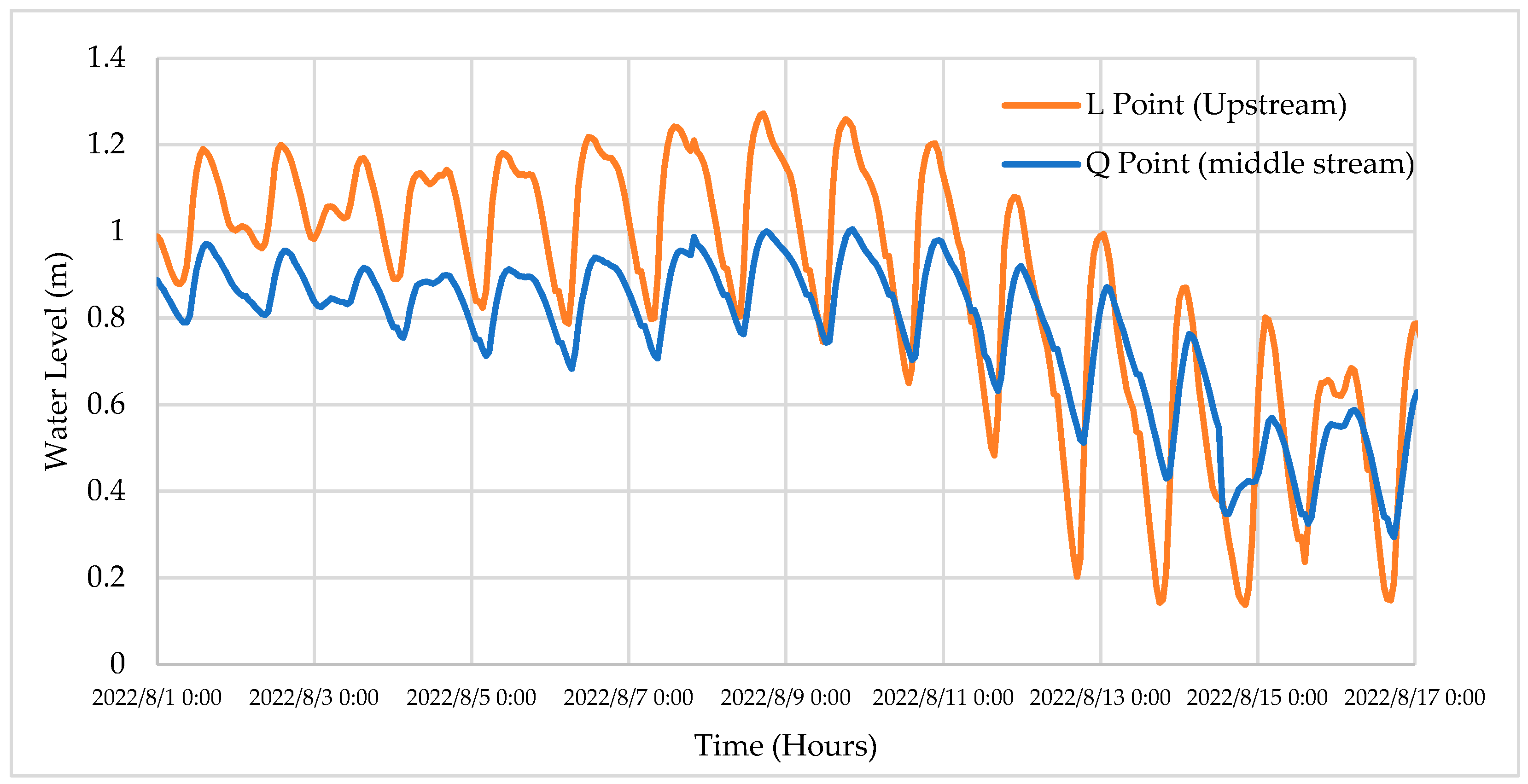
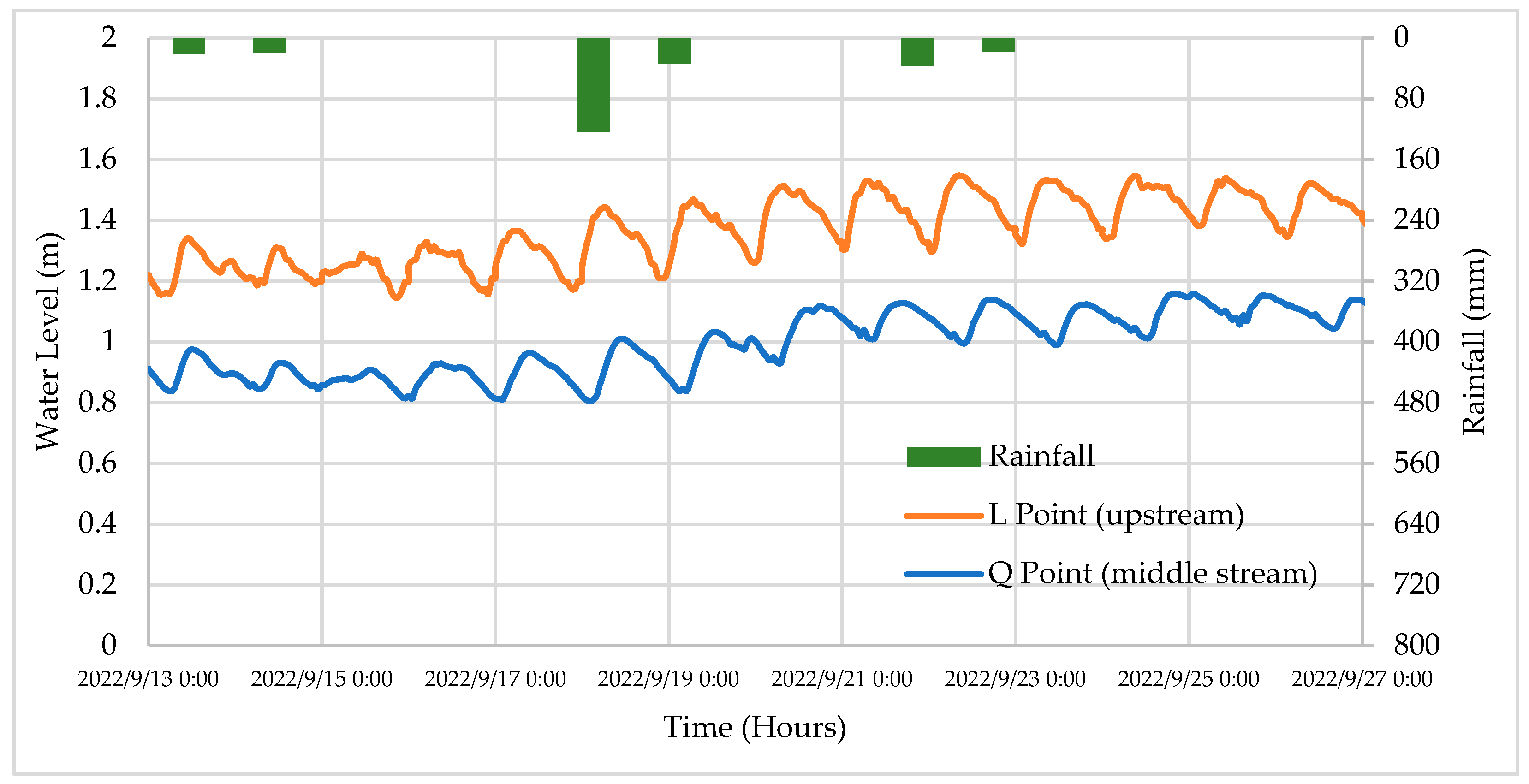


| No | Point | Season | Water Level (m) |
|---|---|---|---|
| 1 | L | Dry | 1.2 |
| 2 | Q | 0.9 | |
| 3 | L | Rainy | 1.5 |
| 4 | Q | 1.2 |
| No | Point | Season | pH |
|---|---|---|---|
| 1 | L | Dry | 3.91 |
| 2 | Q | 3.07 | |
| 3 | L | Rainy | 5.84 |
| 4 | Q | 5.48 |
Disclaimer/Publisher’s Note: The statements, opinions and data contained in all publications are solely those of the individual author(s) and contributor(s) and not of MDPI and/or the editor(s). MDPI and/or the editor(s) disclaim responsibility for any injury to people or property resulting from any ideas, methods, instructions or products referred to in the content. |
© 2023 by the author. Licensee MDPI, Basel, Switzerland. This article is an open access article distributed under the terms and conditions of the Creative Commons Attribution (CC BY) license (https://creativecommons.org/licenses/by/4.0/).
Share and Cite
Zevri, A. Utilization of a Telemetry Monitoring System for the Dynamics of Water Quantity and Quality in the Dadahup Swamp Irrigation Area. Environ. Sci. Proc. 2023, 25, 41. https://doi.org/10.3390/ECWS-7-14191
Zevri A. Utilization of a Telemetry Monitoring System for the Dynamics of Water Quantity and Quality in the Dadahup Swamp Irrigation Area. Environmental Sciences Proceedings. 2023; 25(1):41. https://doi.org/10.3390/ECWS-7-14191
Chicago/Turabian StyleZevri, Asril. 2023. "Utilization of a Telemetry Monitoring System for the Dynamics of Water Quantity and Quality in the Dadahup Swamp Irrigation Area" Environmental Sciences Proceedings 25, no. 1: 41. https://doi.org/10.3390/ECWS-7-14191
APA StyleZevri, A. (2023). Utilization of a Telemetry Monitoring System for the Dynamics of Water Quantity and Quality in the Dadahup Swamp Irrigation Area. Environmental Sciences Proceedings, 25(1), 41. https://doi.org/10.3390/ECWS-7-14191





